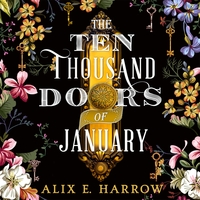Take a photo of a barcode or cover
After hearing so much about it I was so excited to read this book!
It took me until page 60 or so to really get into it, which for me was way too long, but I’m glad I stuck through it because this book was so delightful.
It took me until page 60 or so to really get into it, which for me was way too long, but I’m glad I stuck through it because this book was so delightful.
In the early 1900s, 17 year-old January Scaller is navigating an oppressive life when she discovers that she can travel to other worlds through hidden Doors. The Ten Thousand Doors of January delivers a story about diversity and the search for belonging, wrapped up in pretty prose and imagination.
This novel didn’t totally ensnare me, but it was a lesser trope-y YA fantasy with more substance than most.
While the prose is vivid and flows well, I had a gripe with the scene construction in this book. A lot of the scenes aren’t that strongly crafted, and they kind of skip and jump (by means of passive prose, or the ‘narrator’ voice) to the next event. Can’t speak for others but it made me less engaged with things as they happened.
For instance, (random selection here as it happens throughout the entire book), in the second chapter January is wandering about the house when she goes to her room and finds, in a locked box, a book. That, in this novel, is the entire scene, it lasts for about a page and a half. You could argue that there’s nothing very wrong with that scene, because it takes the character from one place (not having a book) to another (discovery). But couldn’t the scene have been preceded by something else that made the discovery more important to the character at the time? The book and its importance becomes more apparent later, but a story is like holding a reader by a hand and guiding them through to pay off at the end. It would be nice if the hand was solid and pulled you through a fun path to get there.
I wish also there had been more time spent turning important meetings into scenes. Take for example, the way we are introduced to Samuel Zappia (whose scenes with January were sparse but fun):
In the opening chapter, January feels lonely and reflects,
“Samuel Zappia was my only non-fictional friend: a dark-eyed boy with a clinical addiction to pulpy story papers and the faraway expression of a sailor watching the horizon. He visited Locke House twice a weak in a red wagon with ZAPPIA FAMILY GROCERIES, INC. painted on the side in curlicued gold lettering, and usually contrived to sneak me the latest issue of The Argosy All-Story Weekly or The Halfpenny Marvel along with the flour and onions. On weekends he escaped his family’s shop to join me in elaborate games of make-believe involving ghosts and dragons on the lakeshore. Sognatore, is mother called him, which Samuel said was Italian for good-for-nothing-boy-who-breaks-his-mother’s-heart-by-dreaming-all-the-time.”
Is the writing in this quite nice and vivid? Yes, but there’s a glaring problem here. Discussion in spoilers:
Idk, felt forced and like the story was unsure of what it wanted to be at times. But other than those gripes, the novel's strengths are in January’s learning curve, a loyal dog called Sinbad, and the author's imagination.
This novel didn’t totally ensnare me, but it was a lesser trope-y YA fantasy with more substance than most.
While the prose is vivid and flows well, I had a gripe with the scene construction in this book. A lot of the scenes aren’t that strongly crafted, and they kind of skip and jump (by means of passive prose, or the ‘narrator’ voice) to the next event. Can’t speak for others but it made me less engaged with things as they happened.
For instance, (random selection here as it happens throughout the entire book), in the second chapter January is wandering about the house when she goes to her room and finds, in a locked box, a book. That, in this novel, is the entire scene, it lasts for about a page and a half. You could argue that there’s nothing very wrong with that scene, because it takes the character from one place (not having a book) to another (discovery). But couldn’t the scene have been preceded by something else that made the discovery more important to the character at the time? The book and its importance becomes more apparent later, but a story is like holding a reader by a hand and guiding them through to pay off at the end. It would be nice if the hand was solid and pulled you through a fun path to get there.
I wish also there had been more time spent turning important meetings into scenes. Take for example, the way we are introduced to Samuel Zappia (whose scenes with January were sparse but fun):
In the opening chapter, January feels lonely and reflects,
“Samuel Zappia was my only non-fictional friend: a dark-eyed boy with a clinical addiction to pulpy story papers and the faraway expression of a sailor watching the horizon. He visited Locke House twice a weak in a red wagon with ZAPPIA FAMILY GROCERIES, INC. painted on the side in curlicued gold lettering, and usually contrived to sneak me the latest issue of The Argosy All-Story Weekly or The Halfpenny Marvel along with the flour and onions. On weekends he escaped his family’s shop to join me in elaborate games of make-believe involving ghosts and dragons on the lakeshore. Sognatore, is mother called him, which Samuel said was Italian for good-for-nothing-boy-who-breaks-his-mother’s-heart-by-dreaming-all-the-time.”
Is the writing in this quite nice and vivid? Yes, but there’s a glaring problem here. Discussion in spoilers:
Spoiler
In the book’s final chapter we learn that January has written this book for Samuel (who has lost his memories). So, why wouldn’t she start the story as more addressed to him? He’s added in here like an afterthought, without reference to their first meeting, nor put it into a scene for the reader (Samuel) to try to remember. It feels like the ending was either tacked on or poorly thought through, because the very story isn’t constructed at all like it’s addressed to Samuel. In fact, there’s barely any of him in here compared to say, Adelaide or her father's story.Idk, felt forced and like the story was unsure of what it wanted to be at times. But other than those gripes, the novel's strengths are in January’s learning curve, a loyal dog called Sinbad, and the author's imagination.
mysterious
slow-paced
Plot or Character Driven:
A mix
Strong character development:
Yes
Loveable characters:
Complicated
Diverse cast of characters:
Yes
Flaws of characters a main focus:
Yes
An amazing story of a young Victorian women searching for her father through endless number of doors. Along the way, she over comes the brutality of the asylum, escapes from her childhood home, rebels against societies expectations in America and makes friends along the way.
adventurous
challenging
dark
emotional
mysterious
sad
medium-paced
Plot or Character Driven:
Character
Strong character development:
Yes
Loveable characters:
Complicated
Diverse cast of characters:
Yes
Flaws of characters a main focus:
Yes
adventurous
medium-paced
Plot or Character Driven:
A mix
Strong character development:
Yes
Loveable characters:
Yes
Diverse cast of characters:
Yes
adventurous
emotional
mysterious
fast-paced
Plot or Character Driven:
Plot
Strong character development:
Yes
Loveable characters:
Yes
Diverse cast of characters:
Yes
Flaws of characters a main focus:
No
adventurous
mysterious
slow-paced
Plot or Character Driven:
A mix
Strong character development:
Complicated
Loveable characters:
Yes
Diverse cast of characters:
Yes
Flaws of characters a main focus:
No




